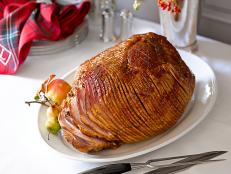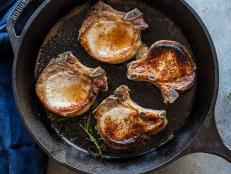How to Cook a Thick Cut Steak
With thick cut steak, it's easy to achieve a crisp, deep brown sear without overcooking.

THEPALMER/Getty Images
They say less is more, but not when it comes to steak! More is more! The biggest advantage of cooking a thicker steak is searing a dark, crisp crust without overcooking the interior. A thick cut steak takes a little bit longer to cook than a smaller steak, so we typically don’t recommend cooking it from start to finish in a pan on the stove. Read on for tips and tricks as well as step-by-step guides to our favorite ways to cook chunky steaks.
Understanding Thick Cuts of Steak
A thick cut steak is at least 1 ½ inches thick, but ideally it is a full 2 inches thick or more to get the full chunky steak experience. Because it takes longer to cook through, a thicker cut will help you to achieve a nice crust on the outside without sacrificing juiciness and flavor on the inside.
Factors to Consider When Choosing a Thick Cut Steak
Order by thickness, not by weight: When you are looking for an extra thick steak, it’s important to order by thickness, not by weight. Every cut of beef is a little different, so the sizing can differ from steak to steak. If you order by weight, the butcher might give you a thinner steak, or trim the steak to make it fit your parameters. Whereas, if you order 1 ½ or 2 inches thick, you are guaranteed a substantial cut of meat that will be easy to cook to perfection.
Marbling matters. Fat is not only the grizzly white edges of the steak, but also what gives a steak its flavor. Tiny swirls of fat run through a steak like the dark veins run through slab of marble, thus the term “marbled.” When a steak is well marbled, the fat melts into the meat as it cooks, imbuing it with rich, beefy flavor.
Buy bright red or pink steaks. Look for steaks that are still bright red or pink. Avoid any that have started to turn grey or brown. While the browning can come from harmless oxidation, it might also indicate the steak has passed its prime.
Opt for bone in. While not available on all cuts, a bone imbues flavor to the surrounding meat and slows down your cooking—like added thickness, this allows more time for caramelization on the outside without overcooking the inside.
Most Popular Types of Thick Cut Steaks
Looking for the best cut of thick steak? Read on to learn more.

grandriver/Getty Images
Ribeye
Ribeye will have the most marbling and then most fat in general. Its fat content makes it both tender and flavorful. While it is “too fatty” for some, it’s a popular option with steak lovers. Bone-in ribeye steaks with the entire rib bone are called Tomahawk or Cowboy steaks and are very popular styles of thick cut steaks.

bhofack2/Getty Images
Strip
A strip or a “New York” strip steak is second to the ribeye in marbling, but still a very flavorful steak. The strip is sometimes favored over the ribeye because of its robust beefy flavor without as much of the fat.

LauriPatterson/Getty Images
Filet/Tenderloin
Tenderness is the real draw of the filet. With the least marbling of these high-quality steaks, the filet is lacking in the rich beefy flavor of the ribeye and strip and is often paired with a sauce to add flavor. The superior tenderness is an even trade for many steak lovers.

photomile/Getty Images
T-bone
The T-bone is a large steak consisting of a t-shaped bone in the middle with a filet on one side and strip on the other. It’s the perfect combination of flavorful strip and tender filet, both with the flavor of the bone imbued.
How to Prepare Your Steak for Cooking
Take the chill off. Pull your steak out of the refrigerator at least 1 hour before cooking. It can sit on the counter safely for up to 2 hours. Bringing it to room temperature will help it cook more evenly.
Season the steak. Season your steak liberally with kosher salt and black pepper at least 45 minutes before cooking. Rub spices all over the meat. With the extra thickness, the steak needs lots of salt and time for it to permeate. The salt will seep into the meat, seasoning it throughout as it sits. You can also salt your steak up to the night before and refrigerate until ready to use.
Pat the steak dry: Right before cooking the steak, pat it dry with a paper towel. Any excess moisture on the steak could ruin the sear.
Preheat. Whether you are grilling, cooking stove top or oven roasting, you need to preheat! Heat the grill, oven and the pan before using. To get a good sear, you need a very hot surface!
Reach for cast iron. While you can use stainless steel, the best tool for steak is a cast iron skillet. Cast iron heats evenly and retains heat for much longer than other types of pans, giving a very even sear all over.
Cooking Techniques for Thick Cut Steaks
Cooking a thick cut steak is like cooking a thin steak; the real difference is time. The timing depends on how you want your steak cooked, but keep in mind that the thickness might as much as double the cooking time.
How to Reverse Sear a Thick Cut Steak Step-By-Step
Pros and Cons of Reverse Searing Thick Steak: Pros: This is method is extremely precise and yields perfectly cooked thick-cut steak with a gorgeous, deep brown crust. It doesn’t require resting, so the steak is piing hot when you serve it. Cons: This method is the longest, taking several hours, so you need to plan in advance.
Step 1: Cook the steak low and slow. Cook it either in a 225 degrees F oven, or using a sous vide machine, until the desired internal temperature is reached, 105 degrees F for rare, 115 for medium rare and 125 for medium, 1 1/2 to 2 hours in an oven.
Step 2: Sear the steak quickly. Add a couple tablespoons of neutral oil to a preheated cast iron skillet, and when hot, add the steak. Sear to a deep golden brown, about 30 seconds to a minute per side. Because the steak is already cooked, the sear happens much quicker than with a raw steak.
Step 3: Slice and serve. The resting phase is unnecessary because of the slow cooking, so simply slice and serve.
Reverse Sear Sous Vide Steak
The restaurant secret to foolproof, perfect steak is finally within the reach of home cooks.
The Pan Sear to Oven Method for Thick Cut Steak
Pros and Cons of Pan Searing Thick Steak and Finishing It In the Oven: Pros: This method is fast, taking about 15 minutes total for a medium rare steak.Cons: The pan and oven can become smoky, as you’re cooking on very high heat the entire time.
Step 1: Preheat. Preheat the oven to 450 degrees. Heat a cast iron skillet over high heat. Pour a couple of tablespoons of neutral oil into the skillet. Once the oil is hot, add the steak.
Step 2: Sear the steak. Cook on one side until the steak is a deep golden brown and a crust starts to develop. Flip the steak and cook on the other side until the browning and crust forms. Check the temperature with a digital thermometer.
Step 3: Transfer the steak to the oven. Transfer the skillet with the steak to the oven. Let roast for a few minutes more. Check the steak for the desired temperature. Remove to a cutting board and let rest for 5 to 10 minutes, then slice and serve.
Pan Seared T-Bone Steak
This pan-seared steak recipe walks you through cooking steak in cast iron, plus tips and tricks for achieving juicy on the inside, crisp on the outside perfectly done steak at home.
How to Grill Thick Cut Steak Step-By-Step
Pros and Cons of Grilling Thick Cut Steak: Pros: It takes minimal time to grill a thick-cut steak, about 15 minutes total. Plus, grilling makes for less cleanup (no spattering the stove) and no smoke inside. Cons: You need to own a grill, and go outside.
Step 1: Prep the grill. Heat the grill to high heat. Use a silicone brush to oil the steak and the grill grates with a neutral oil.
Step 2: Char the steak: Add the steak and cook on one side until deeply browned and starting to char in spots, then flip and repeat on the other side.
Step 3: Check the temperature and serve. Check the temperature with a digital thermometer. Remove to a cutting board and let rest for 5 to 10 minutes, then slice and serve.
Perfectly Grilled Steak
Learn how to grill steaks, including the best steaks for grilling, what temperature to grill steaks at and how long to cook steaks. Plus, discover what to serve with grilled steak and get some of Bobby Flay’s best side dish recipes.
Take the Steak’s Temperature
A thick steak may look fully cooked on the outside while still raw inside. That is why, even with visual cues, it is important to use a meat thermometer, preferably a digital/quick read. Jab the thermometer into the thickest part of the steak, making sure not to touch a bone. Check for your desired temperature.
Important Tip: a hot steak will continue to rise in temperature 5 to 10 degrees after removed from the heat. As a result, you should pull a steak from the heat a few degrees below the desired temperature.
Guide to Steak Temperatures
Rare: 125 degrees F; Pull from the heat at 120 degrees F
Medium-Rare: 130 to 135 degrees F; Pull from the heat at 125-130 degrees F
Medium: 135 to 140 degrees F; Pull from the heat at 130-135 degrees F
Medium-Well: 140 to 150 degrees F; Pull from the heat at 135-140 degrees F
Well-Done: 155 degrees F +
Cooking times
Steaks vary significantly in how long they take to cook, and that’s why most recipes will give cooking time ranges. Even two steaks of the same thickness and weight might cook at different speeds because of slight variances in marbling and muscle. The below cooking times will get you in the right ball park for a steak that is about 2 inches thick. As you add thickness, add an extra minute or so per inch, and keep in mind that the extra minute will probably be in the oven, as the searing time might be the same.
Medium-rare: 4 to 6 minutes (an internal temperature of 135 degrees F)
Medium: 6 to 8 minutes (an internal temperature of 140 degrees F)
Medium-well: 8 to 10 minutes (an internal temperature 150 degrees F)
Resting Thick Cut Steak
One of the most important steps in steak is one that is often overlooked: resting. While the steak cooks, the juices inside get hot and move towards the center, away from the heat. As the steak rests, the juices redistribute throughout the steak, so that it is evenly cooked and juicy. If you cut the steak before it rests, the juices will run out and only the center will be tender. Tent the steak with foil and let it rest for 5 to 10 minutes and the steak will still be warm for slicing!



































































